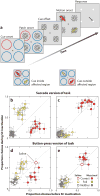Superior colliculus and visual spatial attention
- PMID: 23682659
- PMCID: PMC3820016
- DOI: 10.1146/annurev-neuro-062012-170249
Superior colliculus and visual spatial attention
Abstract
The superior colliculus (SC) has long been known to be part of the network of brain areas involved in spatial attention, but recent findings have dramatically refined our understanding of its functional role. The SC both implements the motor consequences of attention and plays a crucial role in the process of target selection that precedes movement. Moreover, even in the absence of overt orienting movements, SC activity is related to shifts of covert attention and is necessary for the normal control of spatial attention during perceptual judgments. The neuronal circuits that link the SC to spatial attention may include attention-related areas of the cerebral cortex, but recent results show that the SC's contribution involves mechanisms that operate independently of the established signatures of attention in visual cortex. These findings raise new issues and suggest novel possibilities for understanding the brain mechanisms that enable spatial attention.
Figures






References
-
- Aizawa H, Kobayashi Y, Yamamoto M, Isa T. Injection of nicotine into the superior colliculus facilitates occurrence of express saccades in monkeys. J Neurophysiol. 1999;82(3):1642–46. - PubMed
-
- Bell AH, Fecteau JH, Munoz DP. Using auditory and visual stimuli to investigate the behavioral and neuronal consequences of reflexive covert orienting. J Neurophysiol. 2004;91(5):2172–84. - PubMed
-
- Benevento LA, Port JD. Single neurons with both form/color differential responses and saccade-related responses in the nonretinotopic pulvinar of the behaving macaque monkey. Vis Neurosci. 1995;12(3):523–44. - PubMed
Publication types
MeSH terms
Grants and funding
LinkOut - more resources
Full Text Sources
Other Literature Sources

